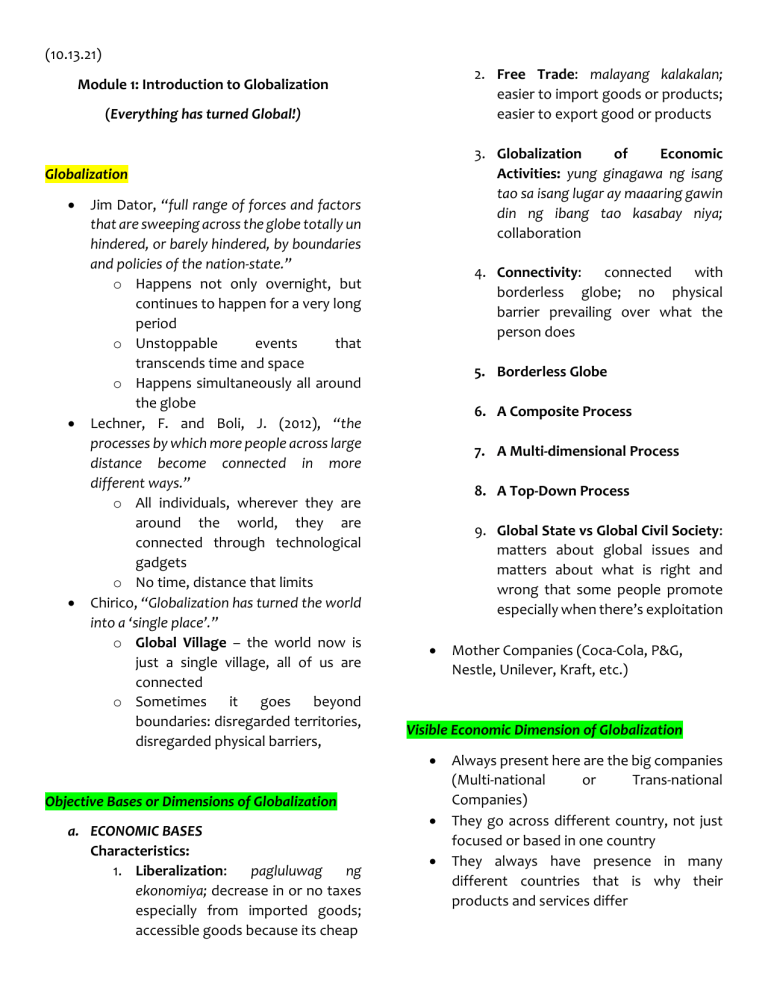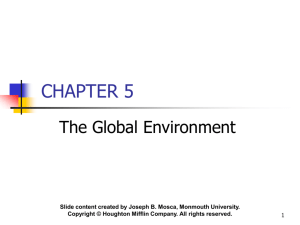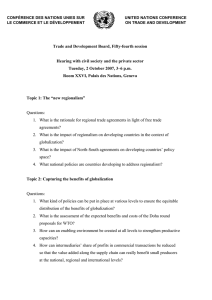Globalization: Economic, Cultural, & Political Bases
advertisement

(10.13.21) 2. Free Trade: malayang kalakalan; easier to import goods or products; easier to export good or products Module 1: Introduction to Globalization (Everything has turned Global!) 3. Globalization of Economic Activities: yung ginagawa ng isang tao sa isang lugar ay maaaring gawin din ng ibang tao kasabay niya; collaboration Globalization Jim Dator, “full range of forces and factors that are sweeping across the globe totally un hindered, or barely hindered, by boundaries and policies of the nation-state.” o Happens not only overnight, but continues to happen for a very long period o Unstoppable events that transcends time and space o Happens simultaneously all around the globe Lechner, F. and Boli, J. (2012), “the processes by which more people across large distance become connected in more different ways.” o All individuals, wherever they are around the world, they are connected through technological gadgets o No time, distance that limits Chirico, “Globalization has turned the world into a ‘single place’.” o Global Village – the world now is just a single village, all of us are connected o Sometimes it goes beyond boundaries: disregarded territories, disregarded physical barriers, 4. Connectivity: connected with borderless globe; no physical barrier prevailing over what the person does 5. Borderless Globe 6. A Composite Process 7. A Multi-dimensional Process 8. A Top-Down Process 9. Global State vs Global Civil Society: matters about global issues and matters about what is right and wrong that some people promote especially when there’s exploitation Visible Economic Dimension of Globalization Objective Bases or Dimensions of Globalization a. ECONOMIC BASES Characteristics: 1. Liberalization: pagluluwag ng ekonomiya; decrease in or no taxes especially from imported goods; accessible goods because its cheap Mother Companies (Coca-Cola, P&G, Nestle, Unilever, Kraft, etc.) Always present here are the big companies (Multi-national or Trans-national Companies) They go across different country, not just focused or based in one country They always have presence in many different countries that is why their products and services differ b. CULTURAL BASES Globalization had widely affected not just the economy, but also in the manners of living (culture) Consumption behavior: before it was just based from needs and wants; now our consumption behavior is affected because of hype, what we see especially the trends (leads to problems about the rightness or wrongness of an act) Korean Wave We are affected by social media especially during pandemic Divers of Globalization Nagtutulak sa globalisasyon 1. Technology 2. Population Pressures (If this works, the impact of globalization on an individual is really great) c. POLITICAL BASES The more we are connected because of globalization, the more we understand the importance of human rights and laws We also understand the importance of promoting freedom of each and every one, be vigilant of government abuse We are more participative in the era of globalization because of the use of technology National Leaders are more connected because of globalization (10.21.21) The buyer of such goods and services is referred to an “importer” who is based in the country of import, whereas the overseas-based seller is referred to as an “exporter.” Module 2: Global Economy The Global Economy - One of the most important topics in globalization - Discusses about how the wealth of the world is being redistributed or distributed to the different parts of the globe “Import” is any good (e.g., a commodity) or service brought in from one country to another in a legitimate fashion, typically for use in trade (ex. cars from Japan to Phil.) It is a good that is brought in from another country for sale. Import goods or services are provided to domestic consumers by foreign producers. An import in the receiving country is an export to the sending country. - Includes the business cycles and global trade The economy of the world! The international exchange of goods and services that is expressed in monetary units of account (money) Business cycles (expansion and recession) Consumer confidence Trade Balance World Economy Controlled progressive or industrialized states or countries Consists of different blocks THE ONCE MIGHTY UNCLE SAM - Previously, the largest trading nation Been surpassed by China (by 2010, largest trading nation) Exports the most to Canada, imports (like, everything) comes from China There are tons of competition, loss of American jobs Exports vs Imports “Exports” refers to selling goods and services produced in the home country to other markets (traditional exports) Export goods or services are provided to foreign consumers by domestic producers. 1. Trade Deficit: A nation spend more on imports and then it earns from exports (more imports than exports) 2. Trade Surplus: A nations earns more exports and then it spends on imports copyrights. (more exports than imports) - every state around the world would always aim to have a trade surplus Economic Trade War US vs China (2020) More trade deficit on the part of United States China receiving trade surplus Trade war (Donald Trump; limit and placing tariffs on Chinese products) Tariffs: taxes that are being imposed on imported brands (prices of goods go higher) Trade War China Protectionism (clear manifestation) – trying to protect your economy (protectionist policy) o Tariffs – taxes on imported goods (special taxes) Depicted as the global hub for manufacturing (sweatshop of the world) (cheap raw materials; usage of different types of products in a swift manner) o Subsidies – come in the form of tax credits or direct payments (lesser expense whoever use it; ayuda o tulong ng gobyerno) The world’s fastest growing consumer market o Quotas (limits; trading quotas) (its middle class continues to grow) o Currency manipulation deliberate attempt by country to lower its currency value, making exports cheaper and more competitive (normally, exporters would favor a higher dollar exchange rate; higher value) Countries take advantage of cheap labor in China (many manufactures around the world go to China to set up their own manufacturing centers or sweatshops) It plays a vital role in the international economy Accounts for 50% of the world’s GDP growth (normally, importers would rather have a lower dollar exchange rate to buy cheaper products abroad) Economic Performance Economic Box European Union GDP (Gross Domestic Product) The European Union An organization of 27 European countries (before around 28 countries) Major trading block, combined value of imports and exports exceed any single country Launched a single European currency, also known as the Euro The monetary value of all the finished goods and services produced within a country’s borders in a specific time period. (most countries would use GDP as one of their important economic indicators) Location > Nationality All income within a country regardless of producer nationality Excludes income from investments in other countries GNP (Gross National Product) Nationality > Location All income generated by a country’s residents regardless of resident location Exclude income generated by foreign producers within country’s (borders) IT’S A GLOBAL ECONOMY - all our economies are intertwined or connected Module 3: Market Integration, Regionalism & Global Economy Nations around the world work on political, social, and economic conflicts together (settle their differences/conflicts; conflicts do not just affect the involved parties/nation, but also the states which are also trading with the states concerned) (the global economy is very fragile) Market Integration and Regionalism (requisites for Global Economy) MNC – Multinational Corporations Market Integration (big corporations producing goods and services based in different countries; the ones who are responsible in trying to have fluidity in term of flow of funds and knowledge within the international market) International markets and flow of funds and knowledge We are a planet (we stand together, not divided) (10.21.21) Definitions: (it is very important we tend to notice prices of commodities in different place or even states would be having the same effect or price because it means the market is becoming more integrated) When an individual nation prospers, all nations prosper (and more people buy more products, improving the global economy even more) - It is very important that the global economy continues to grow - All countries must be able to set aside their differences in order that their economies won’t suffer: Economic Downturns – likes of depression or recession Occurs when prices among different locations or related goods follow similar patterns over a long period of time. Group prices often more proportionally to each other and when this relation is very clear among different markets it is said that the markets are integrated. Thus, market integration is an indicator that explains how much different markets are related to each other. Regionalism Is the theory or practice of (the people) coordinating social, economic or political activities within a geographical region comprising a number of states. (If there are different people from different states who would try to connect their social, economic, and political background as one, and they consider themselves as single block – regionalism) On an institutional level, regionalism involves the growth of norms, rules, and formal structures through which coordination is brought about. It also implies a realignment of political identities and loyalties from the state to the region. The extent of regional integration may range from cooperation amongst sovereign states on the basis of intergovernmentalism to transfer of authority from states to central decisionmaking bodies, in accordance with supranationalism. (Heywood, 2011, p.482) Market Integration (it may strengthen or weaken other markets; it may strengthen its own market once it gets together or integrates it’s owns economies) (also has something to do, not just integrating, but also knowing your identities; having an identity for yourselves; ethnicities, language) may occur with just about any type of related market. In some cases, the integration within a nation may involve the emergence of similar patterns within the capital, stock, and financial markets, with those trends coming together to exert a profound influence on the economy of that nation. Is the expression of a common sense of identity and purpose combined with the creation and implementation of institutions that express a particular identity and shape collective action within a geographical region. can often be a very positive situation, especially if the merging pattern regarding pricing is indicative of an increasingly prosperous economy, at the same time, assessing integration between markets can also be a useful tool in identifying trends that are less that desirable, and having the chance to begin reversing those (makes markets really competitive; if there would be more areas that would join the market or would integrate within that market, all the resources, financial or raw materials that are being produced within that area, can now be utilized by that block or integrated market, it becomes more stronger; more competitive) (important in trying to come up with market integration; considering oneself as one region) Regionalism Global Economy World-wide economic activity between various countries that are considered intertwined and thus can affect other countries negatively or positively. important in market integration because the market becomes one and at the same time all the resources are channeled as well within that region Example: 1) European Union “HOW WILL MARKET INTEGRATION AFFECT US?” o is a unique economic political union between 27 EU countries o Single and Unified Currency: EURO o EU’s main economic engine is the single market. It enables most goods, services, money and people to move freely (come together in order to strengthen respective economies; weaker economies became far better, those who have better economies are the ones who are sustaining those states which have weaker economies) (in return, the weaker economies, the resources are channeled centrally within that market or region; it enables most good and services to move freely around within that region) 2) ASEAN (Association of Southeast Asian Nations) o Established by the Founding Fathers (10 member states in Southeast Asia plus 1 observer): Indonesia, Malaysia, Philippines, Singapore, and Thailand (they’re still building consensus, trying to feel each other; most of the states in ASEAN are not fairing good in terms of their economy, there are only quite a few: Singapore, Malaysia, and Thailand) World Economy - how important market integration regionalism when we of world economy Very important factor for everyone to consider Refers to the world-wide economy Of all the weapons in the government’s arsenal, monetary policy is by far the most powerful. Unfortunately, it is also the most imprecise. (the economy is one of the ultimate weapons of any country or state can put use in order to pressure other states) True, the government can do some fine control with tax policy to move capital between investments by granting favorable tax status. On the whole, however, governments tend to go for large, sweeping changes by altering the monetary (economic) landscape. o Consensus and Cooperation (the very reason for establishing ASEAN; an arena wherein these countries would be able to talk together, cooperate, and to discuss whether they will push through with market integration) o Treat of Amity and Cooperation in Southeast Asia and Political Geography (Centripetal and Centrifugal Forces) o ASEAN Charter - how regionalism is also being characterized into centripetal and centrifugal force o No single currency yet… - you may do that, divide or unify, by using your economy or economic policies Centrifugal Forces (Divide a State) Ethnic conflict Social injustice Poverty Dictatorial leadership Religious Intolerance Nationalism Loss of Rights Any other divisive force Centripetal Forces (Hold a State Together) Ethnic Unity and Tolerance Social/Economic Equity Just and fair Legal System Charismatic Leadership Religious Acceptance Nationalism Common heritage Common Language Any other unifying force






